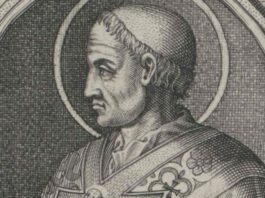
Pope Saint Hormisdas, born in Frosinone in the Roman Campagna, had a vibrant and impactful pontificate, characterized by peace and victory. Before his ordination, he was married and had a son, Silverius, who also became a pope. As a deacon, Hormisdas firmly supported St. Symmachus during his conflict with the antipope Lawrence and the pro-Byzantine group. Although he faced difficulties during his election, St. Hormisdas began his papacy on a victorious note by reconciling with the remnants of the Laurentian schism.
A more significant achievement was soon to follow. The Church of Constantinople had been in schism since 484, due to the actions of Patriarch Acacius. Even after many patriarchs returned to orthodoxy, they resisted removing Acacius’s name from the liturgical tablets. This division was further complicated by Emperor Anastasius’s leanings towards Monophysite heresy. Nevertheless, the Eastern Church’s clergy, monks, and laypeople increasingly desired an end to the schism, which weakened their stance against Monophysites.
An unsuccessful attempt to reconcile was made in 514 when General Vitalian revolted and pressured Anastasius. However, after Anastasius’s death in 517, optimism grew. His successor, the Orthodox believer Justin I, facilitated the reunion, as did popular opinion. A synod at Constantinople sent a representative to Pope Hormisdas to seek reunion.
In response, Hormisdas sent back a delegation with a formula of faith. This was accepted on Holy Thursday, March 28, 519, reuniting the Church of Constantinople with the Catholic Church. This event brought immense joy and relief to the faithful.
The Pope’s formula of faith was crystal clear, reasserting the condemnation of the heresies deemed wrong by the ecumenical councils, and particularly condemning the actions of Acacius. It strongly underlined the primacy and infallibility of the Roman See, proving to be a robust defence for Catholic orthodoxy from then on. It was signed by the patriarch of Constantinople and, eventually, by 2,500 bishops across the East.
St. Hormisdas also rejoiced when he received news that the African Church was enjoying a brief period of peace following the death of the Vandal king Thrasamund.
During his reign, Hormisdas took disciplinary actions and banned the phrase “one of the Trinity was crucified”, due to its misuse as a Monophysite slogan. When he passed away in 523, the Church was generally peaceful, although there were signs of looming troubles in the West.
Photo credit: Public Domain via Wikimedia Commons
The post Pope Saint Hormisdas appeared first on uCatholic.
Daily Reading
Monday of the Second Week in Ordinary Time
Reading 1 Hebrews 5:1-10 Brothers and sisters: Every high priest is taken from among men and made their representative before God, to offer gifts and sacrifices for sins. He is…
Daily Meditation
Fasting and Feasting
Click here for daily readings Have you ever wondered why the Church has so many feast days in the liturgical calendar? It may be harder to realize as the holy…




